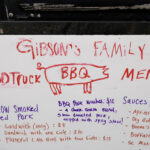The question often arises: “Can a protection-trained dog be safely integrated into a family environment, especially with children?” This is a valid concern for anyone considering a dog for family protection. The good news is, with the right approach, the answer is a resounding yes. The key lies in understanding that a dog’s suitability as a family protector isn’t solely about protection training itself, but fundamentally about temperament and responsible ownership. This article will delve into what truly makes a dog the best family protection dog, focusing on temperament, training, and ensuring a harmonious and safe home environment.
What Makes a Dog a Good Family Protection Dog?
Choosing the right dog for family protection involves more than just selecting a breed known for guarding instincts. It’s about finding a dog with the inherent qualities and the right upbringing to be both a capable protector and a loving family member.
Temperament is Key
The cornerstone of a good family protection dog is temperament. A stable, well-balanced temperament is paramount. This means a dog that is confident but not aggressive, intelligent and trainable, and naturally inclined to bond with its family. Aggression towards family members is not a trait of a good protection dog; it’s a sign of underlying temperament issues, often rooted in dominance. The ideal family protection dog is one that is inherently protective out of loyalty and love for its family, not out of a desire to dominate.
Bloodlines Matter
The genetic predisposition of a dog plays a significant role in its temperament. Working bloodlines, carefully bred for generations for specific traits like trainability, courage, and stable nerves, are often preferred for protection work. Breeders who understand bloodlines and temperament are crucial in sourcing a puppy with the right potential. A reputable breeder will prioritize temperament in their breeding program, aiming to produce dogs that are not only capable working dogs but also stable and reliable family companions. They will be knowledgeable about the lineage of their dogs and be able to guide you towards a puppy that suits your family’s needs and lifestyle.
Training vs. Temperament: Addressing Dominance
It’s crucial to differentiate between protection training and inherent temperament issues like dominance. Protection training, when done correctly, enhances a dog’s natural protective instincts in a controlled and responsible manner. It does not create aggression. Dominance, on the other hand, is a personality trait that can manifest regardless of training. A dominant dog may challenge authority and exhibit unwanted behaviors, including aggression, towards family members. Therefore, addressing dominance is key to ensuring a safe and harmonious relationship with any dog, especially one intended for family protection. Focusing on training to manage dominance, rather than solely on protection work, is essential for a well-adjusted family protection dog.
Understanding Dominance vs. Protection Drive
To properly select and train a family protection dog, it’s important to understand the difference between dominance and protection drive, as well as another key concept: prey drive.
Dominance Explained
Dominance, in canine terms, refers to the social hierarchy within a pack. In a domestic setting, this translates to the dog’s perception of its place within the family “pack.” Signs of dominance can emerge as a dog matures, typically between 15 to 36 months, with 18 months being a common point. These signs can include growling around food bowls, guarding toys, resisting commands, or challenging the owner’s authority. It’s important to recognize that dominance is not breed-specific; it can occur in any breed, even small breeds. Dominance is a temperament trait that needs to be addressed through consistent leadership and training to establish a clear pack structure where the humans are in charge.
Prey Drive Explained
Prey drive is a distinct instinct from dominance and protection drive. It’s the innate desire to chase, capture, and sometimes kill prey. This drive is triggered by movement, particularly fast movement of small objects. In a family context, children, with their quick movements, running, squealing, and high-pitched voices, can inadvertently trigger a dog’s prey drive. This is not an act of aggression or dominance; it’s an instinctual response. Small children should always be closely supervised around all dogs, regardless of breed or training, to prevent accidental triggering of prey drive, which could lead to chasing and nipping or biting. Understanding prey drive is crucial for managing interactions between children and dogs, especially in a protection dog context.
Raising a Family Protection Dog: Groundwork is Essential
Raising a family protection dog requires a proactive approach that starts from puppyhood. Establishing clear boundaries, consistent training, and a strong bond are crucial for developing a dog that is both protective and safe within the family.
Puppy Groundwork: Building a Foundation
Early puppyhood is the ideal time to establish a solid foundation for a family protection dog. A structured “groundwork program” focused on basic obedience, socialization, and establishing pack structure is essential. Puppy groundwork should focus on teaching the puppy its place in the family, that humans are the leaders, and that obedience is expected. This includes basic commands like sit, stay, come, and down, as well as leash manners and crate training. Socialization is equally vital, exposing the puppy to various sights, sounds, people, and other dogs in a positive and controlled manner. Early socialization helps prevent fear-based aggression and ensures the dog is well-adjusted to different environments and people.
Dealing with Dominant Tendencies: Establishing Pack Structure
For adult dogs, especially those adopted or rehomed, addressing potential dominant tendencies is often the first step. Establishing pack structure is crucial. This means consistently reinforcing that you are the pack leader. This is not about being harsh or aggressive, but about being firm, fair, and consistent in your interactions with the dog. Dominance should be addressed from the outset. If a dog challenges your authority, it’s important to address it calmly but firmly. Ignoring dominant behaviors or backing down can reinforce them. Seeking guidance from an experienced dog trainer or behaviorist can be invaluable in establishing and maintaining a healthy pack structure, especially with a dog showing dominant tendencies. Consistency in enforcing rules and boundaries is key to managing dominance and ensuring the dog understands its place within the family.
Choosing the Right Dog: Puppy or Adult and Debunking Myths
Deciding whether to start with a puppy or an adult dog for family protection is a significant decision. Similarly, understanding common misconceptions about protection dogs is important for making informed choices.
Puppy vs. Adult Dog: Considerations for Families
For families, especially those with children or limited experience with protection dogs, starting with a puppy often presents advantages. Puppies raised within the family from a young age naturally learn their place in the pack order, typically at the bottom. This early integration minimizes the chances of dominance issues arising. Puppies are also more malleable and can be trained and socialized according to the family’s specific needs and lifestyle. However, raising a puppy requires significant time, commitment, and consistent training.
Adult dogs, especially rescue dogs, can be a rewarding choice, but require careful consideration. If adopting an adult dog, especially one with unknown history, assessing its temperament is paramount. Look for dogs with a stable and friendly disposition. Be aware that adult dogs may come with pre-existing habits or dominant tendencies that need to be addressed. If considering an adult protection dog, it’s crucial to work with a reputable trainer or rescue organization that can help assess the dog’s suitability for family life and provide guidance on integration and training.
Debunking the “Alpha Dog” Myth: Trainability Over Dominance
A common misconception is the desire for a “big alpha dog” for protection. In reality, the “alpha dog” mentality is counterproductive for both protection work and family life. Truly dominant “alpha” dogs are often stubborn, difficult to train, and may challenge their handlers. The ideal protection dog is not an “alpha” but a dog with high trainability, courage, and a strong work ethic, coupled with a stable and reliable temperament. These dogs are eager to please, responsive to training, and reliably controllable, making them far more effective as protection dogs and safer family companions. Focus on finding a dog with a trainable temperament rather than seeking out a dog perceived as “alpha.”
Conclusion: Safe and Secure with the Right Family Protection Dog
The notion that protection-trained dogs are inherently unsafe for families is a misconception. With careful selection, responsible training, and a focus on temperament, family protection dogs can be both loyal protectors and loving family members. The Best Family Protection Dogs are those with stable temperaments, strong bonds with their families, and training that enhances their natural protective instincts in a controlled and safe manner. Prioritizing temperament over breed alone, understanding the nuances of dominance and prey drive, and committing to consistent training and socialization are key to welcoming a safe and effective family protection dog into your home. Remember, a well-bred, well-raised, and well-trained dog is the best foundation for ensuring both family safety and canine companionship.
 A German Shepherd puppy looking alert and playful in a grassy yard.
A German Shepherd puppy looking alert and playful in a grassy yard.


